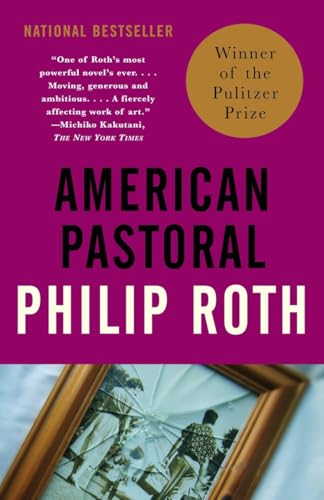Alright folks, pull up a chair! This is my review of American Pastoral, a book that tries to stuff the American Dream, family chaos, and all the mess of the 1960s into one story. I’ve wrangled with this book, laughed, groaned, and maybe spilled a little coffee on the pages (don’t judge me). If you want a no-nonsense look at why this book’s got both brains and heart, and why it sometimes left me scratching my head, you’re in the right place. Let’s get into it!
Reviewing “American Pastoral” by Philip Roth
In a nutsheel
American Pastoral is a modern classic by Philip Roth. This literary novel packs a punch with its smart writing and deep look at the American experience. It’s not a beach read, unless your idea of fun is thinking about the meaning of life while getting sand in your shoes.
The book follows Swede Levov, a guy who seems to have it all—until he doesn’t. Set mostly in the 1960s, it touches big topics like the American Dream, family, identity, and what happens when your world gets turned upside down. Roth’s writing is sharp, sometimes funny, and always honest. You get an inside peek at how a family can unravel and what it means to chase a dream that’s harder to catch than your cat when it hears the vacuum cleaner.
If you like stories that dig into family drama, tackle tough questions, and make you wonder why things fall apart, give this one a try. It’s heavy at times, but worth it. Plus, you get to walk around looking smart while reading Philip Roth.
The American Dream Cracks: Lessons from American Pastoral
When most folks think about The American Dream, they see apple pies, white picket fences, and the promise that anyone can make it big. That’s the whole sales pitch, right? If you work hard enough, you’ll hit the jackpot and live happily ever after. Well, “American Pastoral” by Philip Roth takes that idea and gives it a proper wedgie.
In the book, Swede Levov pretty much has it all. He’s handsome, runs a glove factory, marries a beauty queen. Swede seems like the poster child for The American Dream, and honestly, I was a bit jealous at first. But then the cracks show. And by cracks, I mean full-on sinkholes in the front yard.
Roth doesn’t just say the dream can fail, he throws a parade for its failures. Swede’s comfy world gets upended by social unrest, family trouble, and a sense that all the stuff he worked for doesn’t matter when life throws grenades. It’s not just about Swede; it’s about a whole country realizing the dream isn’t bulletproof. The book made me feel like I’d just realized my favorite childhood cartoon was a clever ad for cereal.
So, if you think buying a house on the hill means you’ve won at life, “American Pastoral” will have you re-checking your mortgage paperwork. But the dream crashing is only half the story—wait till you see what happens when family ties get tangled up and tragedy comes to tea. Watch out, the next section might just make you want to call your mom.
Family Breakdown and Personal Tragedy in American Pastoral
Let’s face it: families are weird. I’ve been to enough awkward Thanksgivings to know this. But nobody’s family falls apart quite as dramatically as the Swedes in American Pastoral. Philip Roth paints a picture of a family coming undone, and not just in the normal, “my uncle drank too much champagne” kind of way. No, Swede Levov’s family faces troubles that make my messy closet look like a minor concern.
First, you’ve got Merry, the Swede’s daughter. Bright kid, until she turns into a radical and, well, let’s just say things start to explode from there. Literally. If you’ve ever had a rebellious teenager, trust me, Merry will make you feel much better about your own parenting skills. Roth shows how even the most perfect-seeming families can crumble under pressure. Swede does his best, but he can’t fix what’s broken, no matter how hard he tries. And isn’t that just the worst? When you want to glue the pieces together, but the glue just won’t stick.
The personal tragedy in this book makes me want to call my mom and say sorry for every time I left my socks on the kitchen table. The Swede’s pain catches you off guard and leaves you thinking about your own family, even if your biggest crisis was burning the Thanksgiving turkey.
With all this family drama out of the way, next up, I’ll pull back the curtains and show you how the 1960s weren’t all peace signs and good vibrations—so get ready to boogie into the wild world of history!
Understanding the 1960s: American Pastoral and Its Turbulent Backdrop
Let me take you on a little trip back to the 1960s. No, I don’t have a DeLorean, but I do have American Pastoral, and that’s pretty much the same thing—except with less flux capacitor and a lot more angsty teenagers. This decade in America saw major changes. There were civil rights marches, Vietnam War protests, and the rise of youth culture. Suddenly, Elvis wasn’t the wildest thing on the block anymore. It was a time when every parent started to question, “What is my kid doing in the basement?” and “Is that smoke I smell?”
In American Pastoral, Philip Roth uses this wild historical backdrop to show how national chaos sneaks into quiet suburbia. With Rapid City, New Jersey, you get the sense that even a peaceful glove factory isn’t safe from the waves of change crashing through the county line. All those dreams about a perfect life start to feel shaky. Even the Swede, who seems like the most all-American, apple-pie-eating guy ever, can’t dodge the turmoil. Roth makes the 1960s feel real with mentions of political activism, race riots, and generational strife. It’s like the background music in a horror movie: you know something bad might jump out at any minute.
American Pastoral is not just telling us the story of a family—it’s showing how history can barge right into your living room, muddy shoes and all. Next, let’s dust off the armchair and take a deep look into our main man, the Swede, who is as complicated as a Rubik’s cube that’s missing a few stickers.
Main Character in American Pastoral: A Real Hot Mess
Let’s talk about Seymour “Swede” Levov. If you put the phrase “nobody’s perfect” in the dictionary, you’d see his face. In American Pastoral, Roth crafts Swede as a guy who seems to have everything figured out. He’s tall, good at sports, and has great hair (honestly, I’m jealous). Everyone in his New Jersey town wants to be him or marry him. Swede is the American Dream’s poster boy—you want to shake his hand and steal his lunch money at the same time.
But, wow, is he complicated. Roth shows us Swede’s flaws like he’s shining a flashlight under a scary bed. Swede tries so hard to fix his world, but has all the luck of a guy who brought a tennis racket to a baseball game. He avoids conflict, thinks he can smooth-talk his way out of disaster, and is basically hoping if he ignores problems, they’ll go away. Spoiler: they don’t. His endless optimism veers between heroic and just plain clueless. It’s like watching someone try to plug a volcano with a cork.
What I love (and what made me want to flip the table in frustration) is how Roth makes Swede real. He sees the cracks in his life, but keeps on smiling while everything goes kaboom. It made me think about my own blind spots—like the time I tried assembling IKEA furniture without instructions. Big mistake. Swede is trying to follow a map that doesn’t match the ground. Painful, but so true.
Would I recommend American Pastoral? For sure. Come for the character study, stay for the emotional rollercoaster! Just keep your expectations balanced—Swede sure didn’t.
Conclusion
Well folks, that wraps up my review of American Pastoral. This book gave me a lot to think about—plenty of drama, sadness, and a few “wait, what just happened?” moments. Roth paints a sharp picture of the so-called American Dream, and how fast it can crumble when life throws curveballs. Swede Levov is a tough nut to crack, but watching his life fall apart is both hard and fascinating. It’s not all perfect though—some bits drag on longer than your grandma’s stories at Thanksgiving. But if you want a book that makes you feel (and maybe sweat a little), this one is worth a go. Thanks for sticking with me, and don’t forget to check your own gloves for holes—life’s messy, after all!


